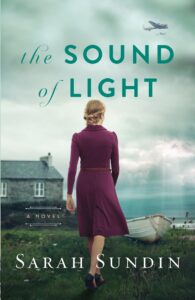Sarah Sundin, @sarahsundin
The scene is running at a nice clip. My heroine is making a strong decision that will propel her into action. The dialogue is flowing, the plot is humming, and . . . wait, which tram line will she take? What’s the scenery like? What was the weather like that day?
And the scene screeches to a stop.
You’ve been there at one point, no matter which genre you write. Your scene is hopping, then you stumble upon a detail to research or ponder or check in your notes.
Recently in a workshop at a writers’ conference, a writer bemoaned this dilemma. She simply couldn’t move. She’d take one step and stop. Another and stop. And her story wasn’t progressing.
I offered the advice I’ve learned the hard way. When you hit those roadblocks, you have two choices—stop and research now, or step around the hole and continue.
How do we decide which tactic to choose?
When to Stop
Stopping and researching is the best decision if the detail greatly affects story or character. If that detail could determine whether or not your scene is feasible, it’s better to find that out now rather than after the scene is written.
Another time you can stop and research is when the scene feels stuck and you need more noodling time. Use your research time to noodle. Maybe that research tidbit is just what you need to unstick that scene!
This is also a fine option if you have plenty of time and if you know where your scene is going—if you know this so well that stopping won’t derail your train of thought.
When to Go
However, stepping around that research hole and writing the scene regardless is often the best decision. Especially if you’re short on time.

First, you don’t want to stop the flow of the scene. The flow is magical! When the characters are talking and you’re there with them, don’t step out of “the zone.”
Second, the details we want to research often relate to scenery. While scenery lends so much to the story, not just the pictures formed in the reader’s mind but mood and thematic elements, it can be layered in later. Knowing which tram line my heroine takes in Copenhagen in 1943 is a fun little thing, but it doesn’t affect plot, character, or theme. I can add it later.
Third, it’s okay if the research tidbits might change parts of the scene. That’s what editing is for. The important thing—you’ve got the meat of the scene cooked. You can add the sauce later.
But, but, but…how?
I hear you. If you have any perfectionistic tendencies, leaving a hole in your scene leaves a hole in your heart.
Over time, you’ll learn to make peace with writing scenes that resemble Swiss cheese. Because you’ll be finishing those scenes and finishing that book, and then you can edit and make that scene look like cheddar.
Sorry if that was cheesy.
So…how do you do it? The key thing is to label those holes so you’ll remember to fill them in. Here are some ways to do that:
- Type in a nonsense word or a group of letters (I use “XX”) that won’t appear in your actual story. Then you can do a “Find” in Word to locate them. I’ll write straight into the story, “Else took the XX tram line downtown” or “Henrik made his way through the shipyard to the XX building.”
- Highlight the information you need to check in yellow (or your favorite color).
- Make comments in track changes.
- Type notes in that free space at the beginning of your chapter. I do this for big-picture things, like “Check British policy toward the Danish resistance at this time.” I also do this after a chapter is written and I find something I’ll need to change when I do my content edit. I do not make those changes until the rough draft is complete.
- Keep a running list—even scratch paper will do!—of things to research or change.
Then keep writing! Make a note to yourself, flag it so you won’t forget, and keep going.
So do you stumble into holes? Have you found ways to step around them?
When the Germans march into Denmark, Baron Henrik Ahlefeldt exchanges his nobility for anonymity, assuming a new identity so he can secretly row messages for the Danish Resistance across the waters to Sweden. American physicist Dr. Else Jensen refuses to leave Copenhagen and abandon her research—her life’s dream—and makes a dangerous decision to print resistance newspapers.
As Else hears rumors of the movement’s legendary Havmand—the merman—she also becomes intrigued by the mysterious and silent shipyard worker living in the same boardinghouse. Henrik makes every effort to conceal his noble upbringing, but he is torn between the façade he must maintain and the woman he is beginning to fall in love with.
When the Occupation cracks down on the Danes, these two passionate people will discover if there is more power in speech . . . or in silence.
Sarah Sundin is an ECPA- and CBA-bestselling author of World War II novels, including The Sound of Light (coming from Revell, February 2023). Her novels Until Leaves Fall in Paris, When Twilight Breaks, and The Land Beneath Us were Christy Award finalists, and The Sky Above Us won the 2020 Carol Award. A mother of three adult children, Sarah lives in Southern California and enjoys speaking for church, community, and writers’ groups. She serves as Co-Director for the West Coast Christian Writers Conference. You can find her at http://www.sarahsundin.com




Comments 2
Great post! I’m very much a perfectionist when it comes to my scenes, and don’t like to leave holes. But recently I’m learning the benefits of not stopping at every road bump, and just keep writing. Your ideas of how to fill the holes until we get back to them are very helpful. Thank you for taking the time to write this. God Bless.
Thanks for your post, Sarah, and for your humorous touches! :). Like you, I mostly go around the holes while making notes to myself in ALL CAPS to distinguish them from the manuscript proper. Unless the scene absolutely needs the bit of historical research right then and there, I wait until later so as not to interrupt the flow of the story. It’s dangerous to leave the ZONE unless there’s an emergency.